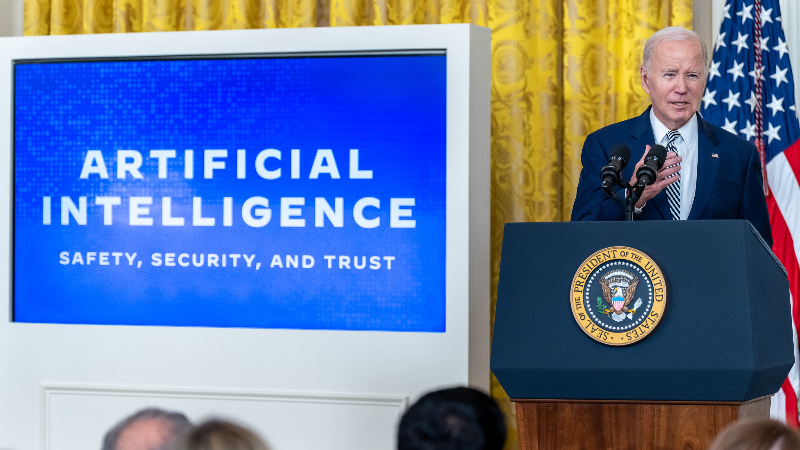
Federal agencies have been meeting “key” deadlines from President Biden’s artificial intelligence (AI) executive order (EO) and are even ahead of schedule on a handful of tasks, according to a three-month progress report the White House released today.
The administration unveiled its much-anticipated AI EO on Oct. 30, directing 50 Federal entities to take nearly 150 specific actions to implement guidance covering eight broad areas of policy.
The White House’s Jan. 29 factsheet listed nearly 30 directives Federal agencies have completed since being tasked with the jobs 90 days ago, including three actions that were completed ahead of schedule and seven that did not have specific deadlines.
“Agencies reported that they have completed all of the 90-day actions tasked by the E.O. and advanced other vital directives that the Order tasked over a longer timeframe,” the White House wrote. “Taken together, these activities mark substantial progress in achieving the EO’s mandate to protect Americans from the potential risks of AI systems while catalyzing innovation in AI and beyond.”
The AI EO directed a sweeping range of actions within 90 days to seize the promise and manage the risk of the emerging technology in eight categories: safety and security; privacy; equity and civil rights; supporting consumers and workers; innovation and competition; American leadership; and government use of AI.
The White House highlighted that, within 90 days, the Department of Commerce proposed a draft rule to compel U.S. cloud companies that provide computing power for foreign AI training to report that they are doing so.
The factsheet also notes that nine agencies – including the Departments of Defense, Transportation, Treasury, and Health and Human Services (HHS) – completed risk assessments covering AI’s use in every critical infrastructure sector.
On the workforce front, the White House highlighted that the National Science Foundation (NSF) began the EducateAI initiative to help fund educators creating high-quality, inclusive AI educational opportunities at the K-12 through undergraduate levels.
HHS also established an AI Task Force within 90 days to develop policies to provide regulatory clarity and catalyze AI innovation in healthcare.
Other deadlines agencies met within the first three months include the launch of NSF’s National Artificial Intelligence Research Resource (NAIRR) pilot, the Office of Personnel Management’s government-wide direct hire authority for AI positions, and the establishment of the Energy Department’s Office of Critical and Emerging Technologies to coordinate the development of AI, among other tasks. The full list of 29 actions can be found here.
The White House’s three-month progress report comes as lawmakers express concerns over agencies’ ability to meet the demanding deadlines.
“The EO tasks Federal agencies with a massive laundry list of roughly 150 action items to take over the next year and beyond. Dozens of regulations and guidance documents will be issued, every major agency and many minor ones are enlisted in the effort,” House Oversight Subcommittee on Cybersecurity, IT, and Government Innovation Chairwoman Nancy Mace, R-S.C., said during a December hearing. “I’m a little skeptical Federal agencies will keep to the timetable of action laid out in the documents because their track record is pretty useless.”
Initial reaction from the private sector to the White House announcement was positive.
“We applaud the administration for moving quickly and expansively in their efforts to catalyze and guide federal use of AI,” said Tom Oliver, GDIT’s VP of digital consulting and solutions.
“At GDIT, we agree adopting AI requires striking that right balance between accelerating innovation and implementing the technology safely and securely,” Oliver said. “We are collaborating extensively with federal agencies to implement AI, including helping customers complete their critical infrastructure AI risk assessments. President Biden’s Executive Order has gotten off to a great start with much more work to come. We look forward to doing our part in advancing the safe and secure use of AI.”
